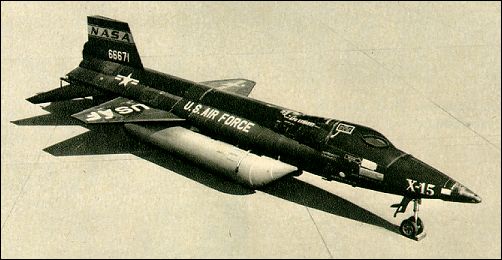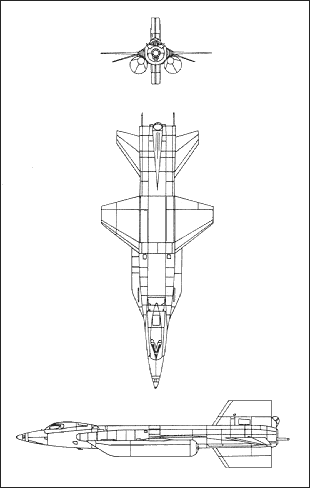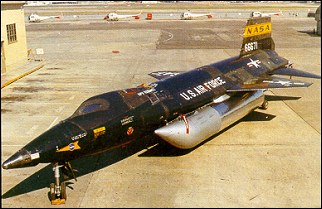|
| The X-15A was a high-performance research aircraft used to provide date about heating, stability, control and the problems of re-entry into the atmosphere. It was flown faster and higher than any other manned aircraft, achieving a speed of Mach 6.72 or 7,297km/h and an altitude of 107,960m. After 199 flights the X-15 programme was terminated in 1968. Power was provided by a 253.6kN Thiokol (Reaction Motors) XLR99-RM-2 single-chamber throttleable liquid-propellant rocket motor.
| CREW | 1 |
| ENGINE | 1 x Reaction Motors XLR-99 rocket engine, 253.7kN |
| WEIGHTS |
| Take-off weight | 15422 kg | 34000 lb |
| DIMENSIONS |
| Wingspan | 6.7 m | 22 ft 0 in |
| Length | 15.8 m | 52 ft 10 in |
| Height | 4.1 m | 13 ft 5 in |
| Wing area | 18.6 m2 | 200.21 sq ft |
| PERFORMANCE |
| Max. speed | 7297 km/h | 4534 mph |
| Ceiling | 107960 m | 354200 ft |
| David G Findlay, e-mail, 28.02.2014 17:48 Was the operator on a voss leveler that flattened the x 2020 alloy aluminum used for the outer skin. Fabricated in Davenport Iowa at the aluminum company of
America. reply | | Bob Kusterer, e-mail, 18.02.2014 03:36 Anybody know why the landing skids were placed so far aft? The X-15 landed nose high and slammed down on the nose wheel. One of them broke in half on landing. Most planes have the main gear only slightly aft of the CG so you can fly the nose gear down gently. Any X-15 engineers out there know the answer? reply | | Harold Shapiro, e-mail, 04.01.2014 19:25 I worked on the X-15 program for 10 years in the engineering Department. The X-15 was the most enjoyable program to be associated in my 35 year career with North American /Rockwell. All those associated with this program became family. reply | | L. J. Steinmehl, e-mail, 06.03.2011 04:13 I worked at NAA in El Segundo before my senior year at UCLA in 1959 as an engineering draftsman, doing some drawings for the T-39 wing struts. My break time was spent hanging on to the fence that separated the airport runways (LAX) from the NAA grounds. I fell in love with aviation then, watching an occassional F-100 land. One day the X-15 was parked by the hanger with a ladder /stairs to the open cockpit. I climbed into the cockpit and just to sit in the X-15 was a real thrill for a 20 year old. And yes, I ended up flying with the Navy (T28s in training!) and subsequently with the airlines. Great career. reply | |
| | Douglas a. Hayman, e-mail, 19.01.2011 09:18 Started at NAA Oct. 15, 1956,(7 days after turning 18) as a machine shop trainee,on lathes. Worked in Dept. 1 for about 1 year, then transfer to Dept. 29 on nights were I work in the short run section making parts for the helium pressure regulator on the X-15. Transferred planning as a machine parts planner on the XB-70. Viewed the X-15 that blew-up on the test stand, Scott Crossfield in the cockpit, when it was laid out in pieces at LA facility. I later transferred to engineering in Saturn Apollo Support group to build the Service Module Teststand. From there I went to Downey as a Design Engineer on the Apollo Service Module in Service Propulsion Systems. I worked in SPS group with many of the engineers that had designed the X-15, people like Chuck Scarlet & Ted Lewin. Those were exciting times! reply | | Charles P (Pat) Kelley, e-mail, 16.10.2010 23:16 Ahmet: the X-15 was constructed of a nickel-steel alloy called Inconel. Not exactly lightweight, but very heat-resistant. reply | | E. R. Mac Mccloud, e-mail, 20.09.2010 00:19 After leaving the U.S.Navy in 1959, I was employed by North American Aircraft at Downey Ca. Altho my part was very small, I was always proud to say I worked on the
X-15. I worked in the wiring section. We also worked on the Hound Dog Missle for the Air Force. reply | | Ron Krause, e-mail, 21.01.2010 00:08 My Dad, Verdin Krause, sadly passed away May 30, 2009. He was 85. He worked on the verticle stab. at NAA in El Segundo, also worked on many of NAA's aircraft since he started to work there just out of the Marines & Navy reserve. He fought at Pelelieu in the South Pacific. He never talked about much of his service to the USA. After he passed, my Mom told me he got hit in the leg by a Jap sniper and refused a purple heart. He was always my personal hero, but he had the balls to stand behind what I had envisioned him as. His last aircraft he worked on were the XB-70 (I saw the roll-out in Palmdale, Ca. when I was 10 yrs.old). He worked on the Space Shuttle and the B-1A. I served in the USAF and got to work on T-38's, SR-71'S, B-1A, B-1B, Space Shuttle Discovery, and the B-2 Stealth Bomber. Sorry for ranting on, us retired guys have not much else to do. Thanks for reading and hope someone knew my Dad. reply | | Ahmet Alegoz, e-mail, 08.01.2009 15:43 Dear Jack,
Was it made by titanium(like SR-71)? I can't find any information about the used materials. Thank's for any information given. reply | | JACK B. BODNE, e-mail, 13.05.2008 05:28 I worked for NAA starting in 1966, as a research engineer. Around late 1967 I was transferred to the advanced X-15 project. We were to rebuild the Mach 6 ship that crashed, into a Mach 8 ship. Two easy things to see that immediately show which ship it is, was the additional external fuel tanks needed on the Mach 8 ship (seen on the one in your site) and an ablation coating (what I was involved in defining), but not seen on this site's photo. That coating was white and designed to ablate under the conditions of the significantly higher temperatures to be encountered. reply | | Robert T. Stetser, e-mail, 05.05.2008 08:58 Landing gear consisted of nose wheel and two retractable rear skids. I am presently reading "X-15: The Edge of Space", detailing this program. I highly recommend it for any high-speed flight fans. reply | | Robert L. Osborn, e-mail, 03.05.2008 00:23 How did this aircraft land? I see that it had a nose wheel. Did it have other gear in the wings or was it a skid landing? Thank you for any information given. Osborn reply |
|
Do you have any comments?
|
| 
COMPANY
PROFILE
All the World's Rotorcraft
|








